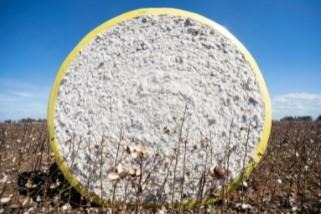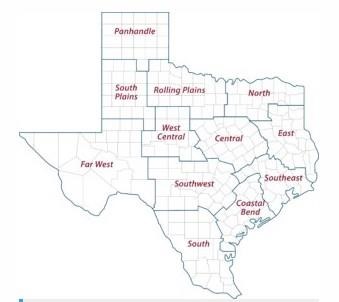As dry conditions continue to grip much of Texas’ Cotton Belt, there are factors producers can control that will improve the chances of establishing a good cotton stands, according to Texas A&M AgriLife Extension Service experts.

Harvested cotton sits in a bale in a field. (Texas A&M AgriLife photo by Laura McKenzie)
On a recent episode of the AgriLife Online Crop Production Podcast, Jourdan Bell, Ph.D., AgriLife Extension agronomist, Amarillo, and Emi Kimura, Ph.D., AgriLife Extension agronomist, Vernon, joined other AgriLife Extension experts to discuss cotton production. Both noted that drought conditions will make crop establishment a challenge.
According to the U.S. Drought Monitor, Texas’ Cotton Belt, which includes much of the Panhandle, Rolling Plains and South Plains, is experiencing severe to extreme drought, with large swaths of the regions entering exceptional drought status as of March 10. Drought conditions make establishing cotton stands a challenge, even in irrigated fields.
Bell and Kimura said weather is out of producers’ control, but that by improving cotton seeds’ chance of germination and establishment they can improve yield potential at harvest.
Cotton is more drought hardy than other crops like corn and sorghum, especially after a good stand is established, Bell said. This makes establishing good stands critical when conditions are not ideal for planting.
“Mistakes at planting can haunt you all season,” she said. “Cotton is a plant that can adapt, but we are looking for a good, uniform stand at the start.”
Seed depth critical for cotton stands
Bell said cotton growers know soil moisture is necessary for germination. They know to plant when soil temperatures are 65 degrees or above consistently. Producers may also know the correct seed depth for their chosen varieties. But, she said, they need to make sure planters are delivering seeds to the correct soil microenvironment for success.
Ideal seeding depth could be 0.5-1.5 inches depending on variety, she said, but oftentimes equipment issues can be a contributing factor to success or failure. Producers should check for mechanical issues such as diameter of disc openers, row cleaners, closing wheels, down pressure, loose bushings or bolts, or any other maintenance issue that could result in the planter placing seeds unevenly or too shallow or too deep.
“We talk about planting conditions like soil temperature and moisture, but I don’t think we talk about planters enough,” Bell said. “Unfortunately, we have a negative weather outlook, so planter settings and maintenance are even more critical. Be aware of any issue that might cause bouncing and uneven seeding depths.”
Seed vigor, soil temperature important
Among the factors producers can control, Kimura emphasized soil temperature and seed quality and vigor.
Soil temperatures need to be at least 65 degrees for five straight days, she said. So, producers should avoid planting if soil temperatures are good, but a cold front is forecast to arrive over the following five days.
Challenging conditions place even more importance on growers planting high quality seed, Kimura said. Cotton seedlings often encounter stressful conditions at the beginning of the growing season, and while high seedling vigor may not mitigate the impact of stress factors, it can help.
One method to determine vigor is through the use of the Cool-Warm Vigor Index, which is typically provided by sellers for buyers to refer to before purchasing cotton seed. Vigor can also be tested.
Planning could be moot for dryland producers in many parts of the Cotton Belt if rainfall does not create adequate germination conditions over the next 45-60 days, Kimura said. But irrigated producers can increase the chances of establishing a good stand. And dryland producers can be prepared to plant, and plant effectively, if rains do arrive in their planting window.
“We can’t control Mother Nature, but we can control when and what we plant,” she said. “We can plant really well. Pencil every aspect of production out due to high input costs and have a plan, and then hope for rain.”
AgriLife Extension district reporters compiled the following summaries:
 A map of the 12 Texas A&M AgriLife Extension districts.
A map of the 12 Texas A&M AgriLife Extension districts.CENTRAL
Dry conditions continued with nearly all counties reporting short soil moisture levels. Wheat continued to hang on and looked better. Corn plantings progressed nicely with limited weather-related delays. Temperatures were variable with warm to hot days and occasional freezes overnight. Colder conditions halted planting progress. Cattle remained in fair to good condition with producers continuing to feed hay, but winter forages were limited by drought. Producers were concerned about hay supplies if rains do not arrive to push forage growth. Stock tank levels continued to decline.
ROLLING PLAINS
Conditions were very dry. A fire burned 566 acres. Wheat looked poor and needed some moisture. Supplemental feeding continued for cattle due to very little wheat for grazing. Some cattle looked a little rough coming through the winter, possibly because of poor-quality hay and not enough supplementation. There was plenty of hay, but much of the quality was below normal. Irrigated wheat fields looked good, but some fields were greening up following scattered rains. More rain will be needed for cotton planting. Producers were considering planting corn after threats of frost passes with sorghum plantings to follow.
COASTAL BEND
No significant rains were reported, and soil moisture levels were unseasonably low. Corn planting was in progress, and most fields had emerged. Sorghum and rice were also being planted. Cotton plantings were expected to start as soil temperatures warm up. Pastures and fields needed rain. Cold temperatures and dry conditions continued to delay the emergence of warm season grasses. Livestock producers were still feeding hay and protein as feed prices continued to rise. Livestock markets were holding strong.
EAST
Conditions continued to be dry for some areas, but other areas received good, soaking rains. Corn was planted, but some areas were a little wet for fieldwork. Cotton field preparations continued. Vegetable producers were planting and preparing for planting. Pecan producers were trying to put spray programs together. Timber sales slowed down. Cool-season forages began to grow following some rainfall. Cattle were in fair to good condition with lots of hay and supplemental feed being fed. Forage producers were concerned about fertilizer prices. Ponds were low. Feral hogs continued to be a problem. Sheep and goat raisers reported increased coyote activity.
SOUTH PLAINS
Conditions were very dry across the district. Subsoil and topsoil moisture levels continued to be low. Dryland wheat fields were basically bare due the prolonged drought. A few irrigated wheat fields were in fair condition, but most were in poor condition. Farmers were starting to get fields ready for spring planting. Cattle were on supplemental feed due to the lack of grazing.
PANHANDLE
Conditions were cold and dry. Soil moisture levels were very short to short. A light, dry snow halted farming activity at the end of the week. Snows added minimal moisture to the top 2 inches of the soil profile. Producers were on hold for fieldwork or preparations as they waited for moisture. They were also running pivot irrigation systems on wheat fields trying to get some grazing for stocker cattle. Dryland wheat conditions continued to deteriorate, and cattle were being supplemented on rangelands. Crop, rangeland and pasture conditions were very poor to poor.
NORTH
Soil moisture ranged from short to adequate. Warmer temperatures were starting to initiate winter wheat and oat growth, but freezing temperatures over the weekend slowed progress and any new grass was likely frost burned. Wheat was in mostly good condition and looked better after fertilizer applications, rain and sunshine. Oat fields were in fair to good condition. Stock tanks were refilled from rains in some areas, and the soil was maintaining the moisture well. Producers were gearing up for planting, but there was more rain expected, which could cause delays. Pasture and rangeland conditions were fair to poor.
FAR WEST
Extreme drought conditions continued. Temperatures were in the low 70s except for two days with temperatures in the mid-40s and overnight lows in the 20s. Snow was reported, but there was no measurable accumulation. Blowing sand was starting to cover roads due to high winds and lack of cover crops. Livestock producers were supplemental feeding with protein and hay. Rangelands continued to decline with no precipitation, but warmer temperatures forecast were expected to encourage green up. Lambing and kidding continued. Pre-irrigation continued in the Rio Grande Valley, mainly for Pima and upland cotton. Some alfalfa and pecan orchards were being irrigated. The El Paso County Water Improvement District No. 1 allotted 25% of irrigation water to growers/landowners, and all other irrigations were to be provided through private farm wells. More planted cotton acres were expected due to higher cotton prices.
WEST CENTRAL
Sunshine and warmer temperatures allowed pastures to green up a bit, but they still needed moisture. While some field preparations for sorghum planting began, many producers were waiting for moisture. Fertilizer and fuel prices were a concern. Beef producers were working calves.
SOUTHEAST
Temperatures were cooler than normal, and dry conditions persisted in many areas. Some producers started to plant rice while others continue to prepare fields. Rain was in the forecast. Planted winter forages were doing well with current soil moisture and temperatures. Rangeland and pasture ratings were very poor to fair. Soil moisture levels were very short to surplus.
SOUTHWEST
Very dry and windy conditions continued across the area, and fire danger increased. Pasture and rangeland conditions continued to decline with a lack of moisture. Corn and sorghum planting continued. Wheat conditions were poor due to lack of moisture. Spring lambing and kidding continued. Some producers reported deeper culling of cattle herds. Producers continued to provide heavy supplemental rations for livestock and wildlife.
SOUTH
Soil moisture levels were very short to short in the northern, eastern and western areas of the district and mostly adequate in southern parts. Cold fronts dropped nighttime temperatures into the mid-30s. Fieldwork continued, but most growers were delaying planting until rains improve soil moisture levels. Cool-season vegetable crop harvests continued. Some producers were planting corn and sorghum. Some emerged corn stands looked very good, and some fields were in four-leaf stage. Grain sorghum was coming up but slower due to cool temperatures. Some cotton was planted, but very little had emerged. Warmer temperatures in the forecast could help cotton emergence. Pastures and rangelands were bare in many areas. Ranchers continued to provide heavy supplemental feed rations and cull herds. Stock tanks were low. Cattle sale volumes were above average with reports of feeder cattle prices dropping $20 per hundredweight. Pastures and rangelands were greening up some in areas that received moisture.
Source : tamu.edu